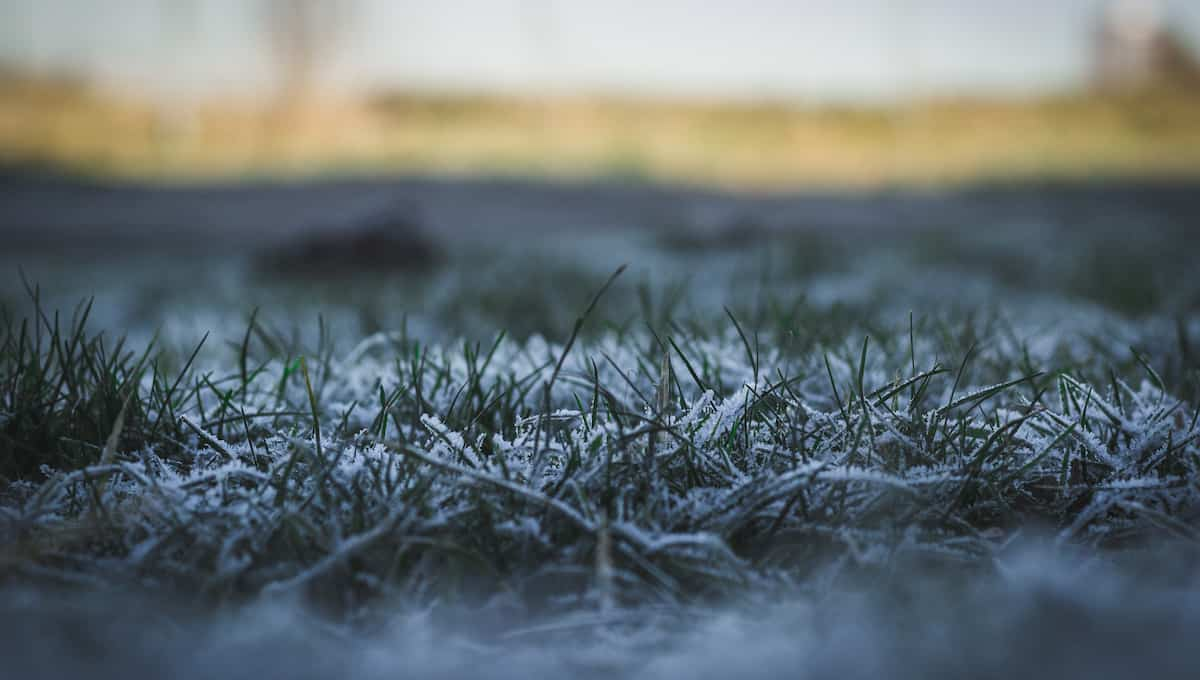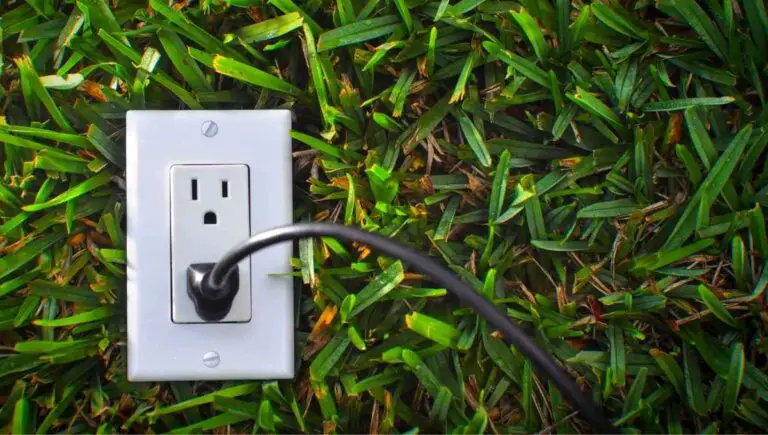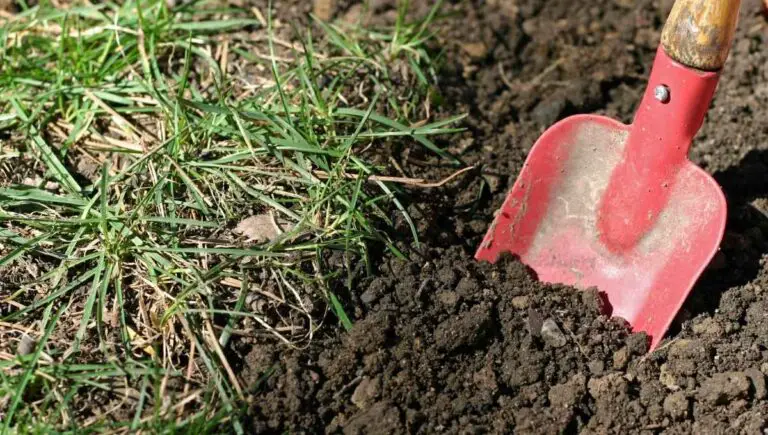Can You Mow Your Lawn in the Winter or Should You Wait?

For many people, the first sign of winter weather means putting your lawn mower in storage until the spring. Not so fast, your lawn still needs a TLC year round. Can you mow your lawn in the winter, or do you need to wait for warmer months?
Mowing lawn in winter can absolutely be done. In fact, lawn care is still a must even in cooler temperatures. Just wait for a dry day and make sure the soil is firm. Set your lawn mower so you can still cut, but leave a lawn height of two inches.
Just because the cold has arrived doesn’t mean you should neglect your lawn. How often should you mow your lawn in winter? Should you cut frozen grass? These could be some of the questions you may ask about preparing your lawn for winter. The answers to which will be discussed in this article.
Can You Cut The Grass When It’s Cold?
Answering the question on whether or not grass can be cut when it’s cold won’t involve a simple yes or no question. To answer this, you have to know the difference between two types of grass: cool-season and warm-season grass.
Cool-Season vs. Warm-Season Grass
Cool-season grass, as aptly named, thrives best in cold areas and is popularly used throughout the North. They give off their vibrant green hues in spring and fall and remain so even when covered with snow.
That being said, this type of grass is best left alone when they are covered in snow or frost. You may still cut it – just wait for the ice to melt or a warm day in winter before you start mowing to avoid damage to the plant tissues.
Warm-season grass, on the other hand, grows best in hot climates and is commonly used in lawns in the south. Even under the intense heat of the sun or long periods of drought, the grass can still grow and display its lush green color. Once the temperatures drop, however, the grass goes dormant and will turn into a straw color. Additionally, mowing won’t be necessary.
Depending on the type you are growing on your lawn, as well as your local climate, grass will go dormant once the cold sets in. If not, it will grow at a much decreased rate. Let’s say you live in a region where frost and snow are not so harsh and are only experienced infrequently. In this case, you may need to mow your grass occasionally during winter so as to maintain a healthy blade height.
Will Frost Damage Fresh Cut Grass?
One of the most wonderful things to look forward to in spring is seeing the condition of your lawn after the dreary winter. It would be good news if no damage has been done to your turfgrass. However, the same thing cannot be said if you see how frost destroyed your lawn.
Lawn damage from harsh winters is a common problem but don’t feel like it’s a hopeless case just yet. A frozen lawn is inevitable and you may be discouraged to work on improving its condition. However, frost can actually help your lawn.
How can frost benefit your turf-grass, you ask? By getting the grass on your lawn acclimated to freeze and extreme cold or what experts would call “hardening.” Overtime, your lawn will become tougher, able to withstand extreme temperatures.
Generally, grass is a hardy plant and can tolerate frost in many circumstances. This explains why you may see lawns that emerge beautifully once winter is over while others are badly damaged. It would be a different story, though, when you walk on frozen grass as significant damage will occur.
You might also enjoy our post on What to Do If Your Neighbor Doesn’t Mow His Lawn
Cutting Grass Before A Freeze
Is it bad to cut grass before a freeze? How cold is too cold to cut grass? You might have concerns regarding cutting grass in cold or freezing weather and what effect it has on your lawn.
The thing is, cutting grass before a freeze will not harm your lawn; in fact, it will be beneficial. Just remember to cut at the right height (discussed more below) and at the right time. Do not mow your lawn right before an expected frost, but rather, cut at such time that will allow grass to recover first.
What To Do With Frozen Lawn?
If you find that your lawn has been kissed by frost and you don’t want to risk damage once spring begins, check out these care tips:
- Avoid your lawn during this time and avoid stepping on frozen grass. Literally, frost will freeze the grass, making it rigid. If applied pressure, such as your shoe stepping on it, leaf cells will rupture causing damage to individual grass blades. You don’t want to do that, or else, you’ll have footprints all over your lawn.
- Do not mow your lawn. While mowing lawn in winter can keep your grass healthy and ready for spring, you should avoid doing it when the ground is frozen.
- Feed your grass so it becomes more resilient for winter. In this case, it would be great to apply a winter fertilizer, like Scotts Turf Builder Winterguard Fall Lawn Food.
- While winter lawn fertilizers are recommended, do not apply when there is frost. The best time to feed grass is in fall.
- If you’re planning to do the last mowing of the season, make sure you don’t cut too short.
What Month Do You Stop Cutting Grass?
As for the temperature, grass generally goes dormant when it’s freezing and you may not need to think about mowing once the temperature drops below 50 deg F. This usually happens around October or November. If you’re wondering when to stop mowing lawn in fall, it’s usually around the time when all the fall leaves have dropped.
Still, there are people who have pushed as far as early December to mow their lawn without problems. That being said, you can mow by then as long as you observe your grass is still actively growing.
You might also enjoy our post on How Short to Cut the Grass Before Winter?
Is It Better To Leave Your Lawn Long Or Short For Winter?
Lawn care for winter is usually done before the cold hits. However, mowing shouldn’t stop even when winter sets in. This also means you shouldn’t park your mower too soon if you think you don’t need it by winter.
The growth rate of grass significantly decreases when temperatures start to drop but it continues to grow, nonetheless. In summer, you might find yourself mowing more often but this will reduce by fall.
As you take into account the type of grass on your lawn and your local climate, you may also wonder, should the lawn be cut short for winter or be left with long leaf blades? Which is best for your lawn? Regardless of the grass type, the best lawn height is neither too short nor too long – it has to be just right.
That being said, you need to determine the best lawn height in preparation for winter, which will be discussed below.
Grass Height For Winter
The best height for your lawn for winter will depend on your location and the type of grass you’re growing. But regardless of the climate condition and the season, maintaining the ideal grass height for winter can result in a lush, healthy, disease-free and weed-free lawn.
What is the ideal grass height for winter? And how short to cut grass in winter? These are common questions asked by anyone who wants to make sure they get to keep their lawn in a good state when winter is over.
Note that not cutting grass in winter would make your lawn look messy and unattractive. But that doesn’t mean you’ll just go ahead and go for a short cut. Doing so can be stressful for the plant – after all, grass is a plant. In addition, it makes for a favorable place for weeds to take over.
Cutting it too short also means you’re doing more harm than good. Too short of a length will force the grass to use more nutrients so it can grow. As a result, the grass may hibernate too early, have weaker root systems, or may grow thin. Worse, it could begin to die.
On the other hand, leaving your grass too long for winter will result in a matted lawn, which will make your grass susceptible to winter diseases such as snow mold.
The exact height for cutting grass has not been universally agreed. Different types of grass may vary in requirements. However, people generally leave an average of two inches of lawn height after making the last cut before the cold freeze.
Two inches is ideal for most cool-season grass types, like the Kentucky bluegrass, but Bermuda may need to be left around one to two inches.
If you leave two to three inches of grass, you are helping optimize photosynthesis for the grass as harsh winter months set it. With that height, you are also promoting the growth of roots and boosting your grass’s stress tolerance.
Mowing The Lawn When Wet
Have you been putting off mowing your lawn because of the rain? You might have just made the right move and saved your lawn because mowing it when the ground is wet is a big no-no. Whether it was a heavy or light rain, you should never cut your grass after it occurs. It’s the same if your sprinklers recently stopped.
Not only will you be hurting your lawn but also your mower. But let’s start with the more obvious problem – it’s a lot difficult to work through a wet lawn. Wet grass has slick blades and they may be tough to cut through. What you’ll likely have is an uneven shred instead of the ideal clean cut you usually get on a sunny day.
Fungal diseases may also develop on your lawn especially when the grass has been cut after a rain. This is because grass clippings will clump up and mat down, blocking the airflow. With excess grass clippings, your lawn could suffer from a disease called brown spot.
At the same time, grass clippings might get stuck to the underside of your mower deck. If it remains there, mold can also develop and ultimately spread to your lawn.
What If Mowing Is Extremely Necessary?
What if the lawn is wet but you need to mow your grass? Should you do it or can you still do it? It is possible to mow wet lawn safely as long as the conditions allow it and you observe safety precautions.
First, you need to test how saturated your lawn is by standing on it. Your feet should not sink in or you shouldn’t see water rising as you do so. If that’s the case, you should forget about mowing and just wait for a dry day.
If there’s not much standing water, you can work on your yard to some extent, as long as your mower has sharp blades and is powered by gas instead of electricity. It’s also recommended to set it to side-discharge mode.
While the mode may leave you with clippings all over your yard that you can manually bag later, it should save you the hassle of dealing with wet undersides of your mower. Keeping in mind these tips should make for a safe mowing practice.
Other Winter Lawn Care Tips
As cold weather approaches, your lawn will start to go into protective mode. This is the best time as any to give greater care to your turfgrass. In this section, we will discuss other important steps to winter lawn care, besides mowing.
Fertilization
The cold weather will make grass grow slower and become hardier in preparation for dormancy. There’s a different story underneath the ground for the roots. The roots of the grass will become stronger and thicker, and will grow deeper into the ground.
With an excellent rooting system, it would be hard to kill off your grass in freezing conditions. Not only that, it will be more capable of enduring droughts, stress and disease when summer comes.
Mowing is not just one of the essential steps for taking care of your lawn and preparing it for winter. Keep in mind, however, that fertilizing is just as important and generally recommended by experts.
Ideally, lawn fertilization should be started early winter or late fall, especially if you have cool-season grass types, like bluegrass or Bermuda. Just before the first freeze, make sure you have fed your grass with either organic or inorganic fertilizer. This should replenish nutrients that have been used up in summer. As winter approaches, the grass will have supplemental feed for the cold season.
Clean Off Debris
Another step to ensuring a healthy lawn by the end of winter is to clean debris, such as grass clippings, tree limbs, and dead leaves, off your lawn. If left to remain there, the debris will create a dead spot on your lawn making it unsightly once spring has come.
Aeration
Water retention is a common problem for lawns in winter. The cold season will interfere with the soil’s capacity to absorb water, thereby making your lawn more vulnerable to damage. Aeration will help solve this problem as it will improve the flow of water and air down to the grass’ roots.
When Can I Start Mowing Again?
If it’s still winter, you can start mowing once the snow has melted or during a warm day (if you leave in warm climate regions). For spring, however, there’s much excitement to prepare the turfgrass for summer use. So what do you usually do with your landscape after winter is over?
While you may be excited to beautify your garden to get ready for spring, don’t do it just yet. Mowing after winter is not so much about waiting for a specific date but rather watching out for the length of grass and making sure it has the right height.
As with mowing before winter, you shouldn’t cut the grass too short to avoid injury and making it susceptible to disease. This means, you may need to wait a bit in spring and see to it that the grass has grown at least two inches before you start trimming.
Conclusion: Can You Mow Your Lawn In Winter?
Preparing your lawn can help it prepare for the harsh cold months to come. Putting in effort to winterize your lawn will also guarantee its vibrant and lush growth by spring.
So, don’t put your lawn mower away just yet. If you don’t commit to prepping your lawn before the cold or frost hits, your landscape may suffer not only from dead grass but also overgrown weeds.
To maintain a healthy lawn throughout winter, it’s best to prepare and continue monitoring your lawn’s condition. Keep it hydrated, fed and trimmed at the best height.
As a recap, when mowing your lawn for winter, always remember to avoid:
- mowing on wet soil
- stepping on frozen grass
- Cutting when there is frost on grass
- cutting grass too short or letting it grow too long before the freeze.







